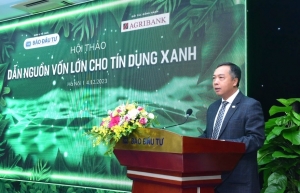Encouraging green urban and construction finance
A regulation framework would help to align businesses with Vietnam’s low-carbon economic growth pathway.
Even though Vietnamese banks are managing to boost financing to fund green projects, the country’s green loan market remains still relatively small.
 |
| Ludwig Graf Westarp Representative, German Federal Association of Small - and Medium-Sized Enterprises Vietnam |
According to central bank data, green loans in Vietnam’s banking sector accounted for only 4.2 per cent of total loans at the end of 2022, up 12.9 per cent from a year earlier, to around VND500 trillion ($21.2 billion). HSBC also assessed anti-climate change initiatives and green finance programmes in Vietnam, still in their infancy.
The green loans have been mostly channelled to green agriculture and renewable energy investments, but urban development, as well as construction, must also become top-priority areas, since urbanisation is progressing quickly, and the course must be set now.
The rapid urbanisation is linked to the tremendous dynamics of the construction sector, contributing about 20 per cent to Vietnam’s GDP but also causing massive environmental impacts due to intense consumption of recourses and greenhouse gas (GHG) emissions.
The reasons are the exploitation of sand and stones to produce construction materials, for instance for cement production, as well as water and power for the buildings.
The energy used by high-rise buildings in Vietnam accounts for around 35-40 per cent of the country’s total energy consumption. For this sector – not just in Vietnam – more sustainable solutions must be found. But there is not just the energy consumption issue, also 38 per cent of the emissions and 38 per cent of the waste comes from the building sector.
To achieve its environmental goals, measures to increase energy efficiency as well as resource efficiency in the Vietnamese building sector are vital. Green buildings are aimed at the maximum of energy-saving potential without reducing comfort – both with minimal intervention and impact on the environment.
To create and construct green buildings, attention must be paid to material selection, energy consumption and planning.
On average, green buildings can save 25-50 per cent of energy, 10-40 per cent of water consumption, and reduce maintenance costs by about 12 per cent. Combined, it can lead to a reduction of operating costs of about 19 per cent and to 35 per cent less emissions.
Vietnam has a high potential for improving its building performance through sustainable building practices, and existing country and bio-climatic specific solutions can be re-integrated.
With the rapid growth of large cities, also the demand on infrastructure is growing. Traffic chaos, a lack of housing, and increasing resource consumption are problems that urgently need to be solved.
This is about sustainable urban development with the aim to reducing resource consumption while improving the life quality of the people.
Modern technologies help to achieve this goal, and resources have to be used more efficiently for a better life and for future generations. The green growth approach seeks to allow growth with the support of more efficient technologies, renewable energies, and a circular economy.
To make it happen, funding and rethinking are important. Here green finance comes into play as it does not only provide funding but also contributes to responsible business conduct and social impact.
To attract more foreign direct investment and provide foreign companies with a more sustainable energy source, Vietnam has demonstrated a strong commitment to renewable energy.
With the increasing importance of investing in environmental, social, and governance, Vietnamese firms will be under greater pressure to comply with such standards, and so they will focus more on sustainable growth and further make public on these issues.
Investors will also demand more from firms. Therefore, firms operating in the high-carbon emission sector need to rethink their business models and strategies.
As Vietnam targets net-zero carbon emissions by 2050, it is seeking solutions to develop green finance to catalyse investments in sustainable projects.
The International Finance Corporation said that the implementation of the national target of reducing total GHG emissions by 9 per cent by 2030 provides a climate investment opportunity worth $753 billion for Vietnam in the 2016 to 2030 period.
Here, international financial institutions are playing an important role in financing green economic development in Vietnam.
Even in the period when the growth rate of overseas funding into Vietnam was slowing down, capital flows into green growth projects have been quite positive.
The green growth trend of international investment organisations is opening up many opportunities to raise capital for Vietnamese firms. Donor countries will continue to shift funds and subsidy schemes towards investing in the development of clean energy technologies.
Vietnam should continue to strengthen its institutional capacities to identify and assess the country’s climate funding ad financing needs and coordinate efforts to assess and use these sources horizontally, across the different sectors, such as urban and construction development, and vertically, at different implementation levels.
Considering Vietnam’s vulnerability to the impacts of climate change, Vietnam should emphasise pursuing funding and financing for its adaptation needs, as it is one of the five countries in the world most likely to be affected by climate change.
Vietnam’s government is increasingly moving from a focus on economic growth towards a model offering more quality of life to its citizens, and has expressed a high commitment to global actions related to climate change and sustainable development.
For several years now, there has been specific interest and regulations to promote low carbon development, and the building sector especially has been targeted regarding energy efficiency. However, the potential of economic incentives to convince urban citizens to take more environmentally friendly decisions is much higher and far from exhausted.
By creating an investor-friendly business climate with a detailed set of corporate governance rules meeting a number of the 17 Sustainable Development Goals of the United Nations, Vietnam is on the right track to encourage green finance for urban and construction development.
 | Vietnam's green credit surge: Navigating towards sustainable finance At a VIR seminar on December 4, in collaboration with the Vietnam Bank for Agriculture and Rural Development (Agribank), key stakeholders congregated to discuss Lighting the Path for Green Financing. The forum signified a critical juncture in Vietnam's path towards sustainable development and emphasised green economic growth. |
What the stars mean:
★ Poor ★ ★ Promising ★★★ Good ★★★★ Very good ★★★★★ Exceptional
Related Contents
Latest News
More News
- JustCo expands business into Vietnam (December 22, 2025 | 17:58)
- Sun Group breaks ground on $2 billion Van Don casino complex (December 19, 2025 | 18:14)
- Rare, beautiful, sustainable: the mark of iconic real estate (December 19, 2025 | 08:00)
- Owner-occupied housing stabilises, paving the way for new growth cycle (December 18, 2025 | 17:04)
- Unlocking urban potential of smart cities (December 18, 2025 | 16:50)
- Green finance offers 'passport' for Vietnamese construction, building materials firms (December 15, 2025 | 08:00)
- Gamuda Land commit long-term investment (December 12, 2025 | 11:49)
- HITC ties up with Evolution to develop AI and hyperscale data centres in Vietnam (December 11, 2025 | 12:09)
- Real estate deals boom via high-profile names (December 08, 2025 | 11:32)
- Industrial segment shaped by M&As (December 08, 2025 | 08:00)

 Tag:
Tag:





















 Mobile Version
Mobile Version